Raven Vs Crow Vs Blackbird
What is that blackbird? Confusing as it may be, differentiating ravens vs crows vs blackbirds is not that hard. We will tell you what to look for in each in the article below.
Ravens, crows, and blackbirds are nearly similar when looked at from a distance. But if you look at them closely, there are many differences between these three birds.
To start, not all black-colored birds are blackbirds, and neither are all blackbirds black. If you thought that sounded confusing, crows and ravens belong to different families of birds, even though all three birds are part of the same order.

In this blog, let us look at all three birds and understand the key differences between them based on some important features.
To limit the scope of the study, we will focus on the common species found in North America – the American crow, common ravens, common grackles, red-winged, rusty, and brewer blackbirds.
How Big Is Each?
Among the three, the raven is the largest bird. At about 22 – 26 inches in length and weighing about 1.5 – 4 pounds, the common raven is quite big and looks pretty mean too.
The American crow falls somewhere in the middle, measuring between 16–20 inches and weighing 0.1 to 1.3 pounds. For context, that’s about the size of a soccer ball in your hands.
The common blackbird is the runt of the lot. It measures somewhere between 9.25 – 11.5 inches and weighs just about 0.22 pounds, about the size of a roll of nickels.
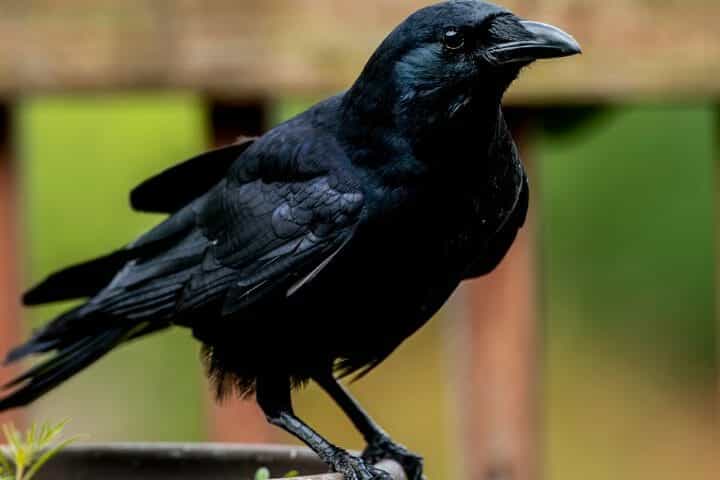
Wingspan
The raven has a huge wingspan of 39 to 59 inches. At its maximum, that’s about 5 feet, not much smaller than the average male adult in America (who is about 5’11”)
American crows have a wingspan somewhere between 33 to 39 inches, which is about the size of ten popsicle sticks kept next to each other.
Blackbirds are the smallest, with wings that are between 13 to 15 inches wide. If you put two pencils on top of each other, they would be about 15 inches long.
Color
Perhaps the most confusing attribute of these three birds is the color. They are all black to some degree. But if you look closer, there are marked differences.
Red-winged blackbirds have, as the name suggests, a yellow and red colored band where the wings bend. Other types of blackbirds don’t have these colors, so they are harder to identify, but you can always pick out a blackbird due to its smaller size.
Between crows and ravens, the key difference is the glossiness of the black color. Ravens are glossy black, and they also give out an iridescence in the colors blue, green, or purple. This is due to the proteins melanin and keratin in their wings, and the way light reflects itself off of them.
American crows are not glossy black, but they do give off a violet-colored hue when you see them from the right perspective.
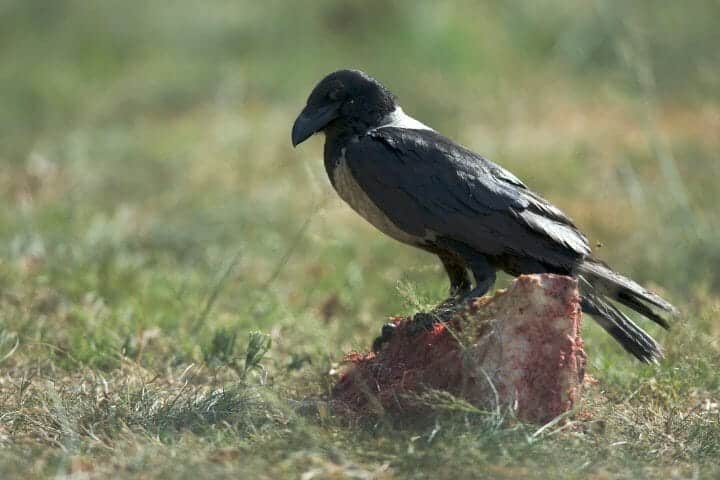
Beak
The most easily distinguishable feature between these birds is their bills. The raven has a rather wide beak that is decidedly hooked at the top.
American crows also have a hooked bill, but the hook is not that prominent. Moreover, American crows have bills that are less wide than that of ravens.
Blackbirds have slender beaks with no noticeable hooking at the top. Their bills are completely straight and very pointed and slender. Their bills look somewhat like a needle from a distance.
Another difference is that both crows and ravens have a bit of bristle around their beaks, but blackbirds don’t have anything. The raven also has a feathery bush under the beak, which flares out when in danger.
Bird Call
Perhaps the easiest way to distinguish between these birds is their typical call. While ravens and crows are cacophonous, blackbirds’ calls are much more melodious.
Between ravens and crows, you have to listen very carefully. Ravens tend to have a croaking quality to their call, while crows make the famous “caw” sound when calling out to other crows.

Mating Cycle
Mating cycles are not easy to observe, but if you are a regular bird watcher and are observing a bird over some time, the mating cycle is the easiest way to differentiate these three types of birds.
Ravens start mating in mid-February and go on breeding till the end of May.
They have the longest incubation and nesting periods among the three, with the eggs needing about 20 to 25 days to hatch and then another 28 to 50 days to fledge.
The eggs themselves are between 1.7 to 2 inches long and 1.2 to 1.4 inches wide. They can come in many colors: blue, green, dark green, purple, brown, or olive.
While the female raven incubates the eggs, the male is responsible for providing food.
The chicks hatch in an altricial state; they have no feathers and are completely blind and helpless. Both the parents provide food and water to the chicks through regurgitation.
American crows start mating in mid to late March. They incubate their eggs for 16-18 days, and then the hatchlings take another 20-40 days to fledge.
Crows can have up to 2 broods in one mating season, while ravens only have one clutch.
The eggs are smaller, about 1.4 to 1.9 inches long and 1 – 1.2 inches wide. They are similarly colored to their raven cousins and come in either pale blue or green colors or a somewhat darker olive green shade.
Cuckoos and koels are brood parasites that often lay eggs in a crow’s nest and lay them there for the mother crow to incubate them.
The female crow takes up the responsibility of incubating the eggs. When they are born, crow hatchlings are helpless and might have just a little bit of downtime.
Crows are social birds, and the process of brooding sees many helpers, including the parent male, younger males, and helper crows, all coming in to feed the hatchlings through the process of regurgitation.
Blackbirds start mating somewhere around early March, and they keep at it till late July.
These birds have the shortest time from eggs to fledglings, with incubation taking only 13 to 15 days and a similar time for the hatchlings to fledge.
The eggs are greenish, bluish, and mottled with brown color. In the blackbird family, the female of the species takes up the job of incubation, but the male helps out from time to time.
While the hatchlings are ready to fledge in about two weeks, they don’t start flying immediately.
Instead, they hide in nearby vegetation, and their parents brood them for about two more weeks before they can fledge.
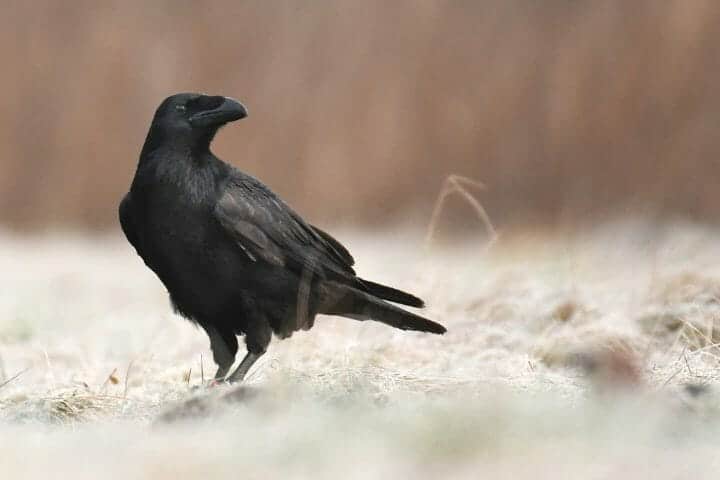
Clutch Size
The raven produces the largest clutch of eggs among the three, which could include as many as 3-7 eggs.
American crows produce somewhere between 3-6 eggs in one go, and common blackbirds produce 3-5 eggs in a clutch.
Life Expectancy and Common Predators
Among the three birds, ravens live the longest, with a common lifespan of up to 10 to 15 years. In captivity, these birds can live anywhere between 40 to 50 years too.
Ravens typically don’t have too many predators because of their size. However, larger birds like hawks, eagles, owls, and martens may attack the young and nestlings sometimes. Ravens are aggressive birds that can defend their nests quite easily.
Crows can live somewhere between 7 to 15 years. In captivity, the longest a crow has lived is about 21 years.
Crows have the same predators as ravens, but crows have another trick up their sleeve – these intelligent birds fight predators in groups. Between crows and ravens, crows are surprisingly more aggressive despite their smaller size.
Blackbirds have an average lifespan of about 2.5 years. Due to their smaller size, blackbirds are often prey to domestic animals like cats and, of course, predatory birds. In the wild, foxes and coyotes can also hunt and kill blackbirds.
Pied currawongs, little ravens, rodents, magpies, and falcons are all predators of these birds.
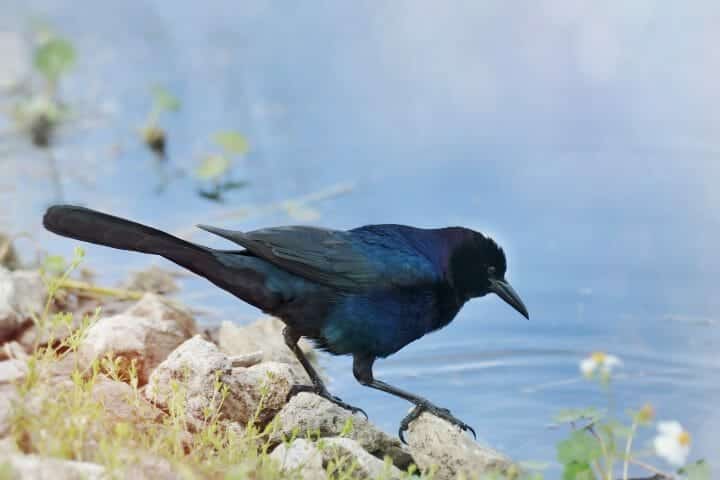
Habitat
Another point of difference between these birds is where you can find each of them.
Common ravens are visible throughout North America, on both the eastern as well as western sides.
Ravens are also found all across Alaska. These birds can live in both wooded areas as well as urban habitats.
American crows are also visible across America. In Alaska, you can see them in and around the southern coastal region. Crows are often spotted in areas that have a few trees or near forest edges.
In cities, you can find them near any place that offers a good source of food, such as city parks or refuse dumps.
Blackbirds are also found all across the US. These birds tend to live near wetlands and coniferous and wet forests.
Among blackbirds, the brewer’s blackbird is more commonly seen near human habitats as well.
Wrap Up
While all three birds may look similar from afar, there is a lot of difference in the size, color, shape, call, and mating habits of these birds.
For the intrepid birder looking to hone her bird identification skills, we hope this article has given you all the pointers that you need to differentiate between these birds.
Thank you for reading, and happy birding!

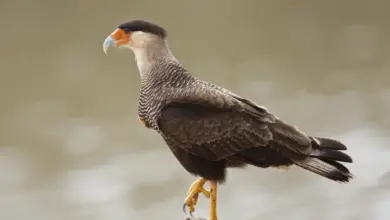

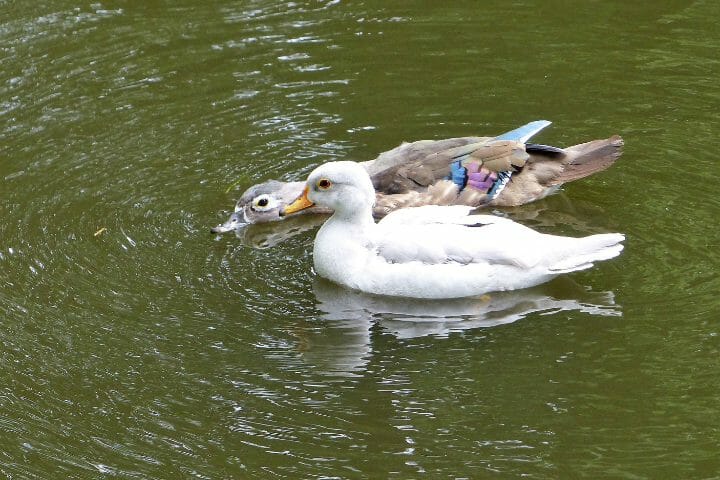

Just watched a crow go into a tree in my yard and it came out with little pink baby birds in it’s beak. I can only assume it was raiding the nest of a mother catbird that lives there. It upset me at first but I figured she probably had a few live babies left in the nest. Then the crow came back and took another. I hope it doesn’t get them all but I’m sure now it knows where they are it will get them all. Nature can be so sad sometimes. Now I feel like I shouldn’t like crows.
I know how you feel. I love watching the birds in my yard and I get very defensive of the nesting birds in the spring when the crows come around. I’ve been known to run outside like a crazy woman and make lots of noise, waving my arms around when I see the crows harassing the smaller birds and their nests. I know crows need to feed their young as well, but the little birds have many more predators than crows do. This past year (2022), my area had what seemed like an unusual number of crows around – more than I can remember in other years – incessantly cawing and making a racket. I’m curious to see if this year is the same.
Thanks for this helpful post, Gordon. I feel better equipped to tell the difference between the crows, ravens, and blackbirds in my area.